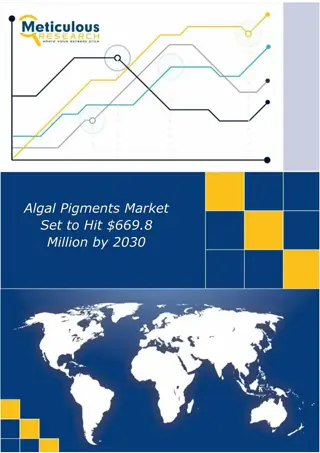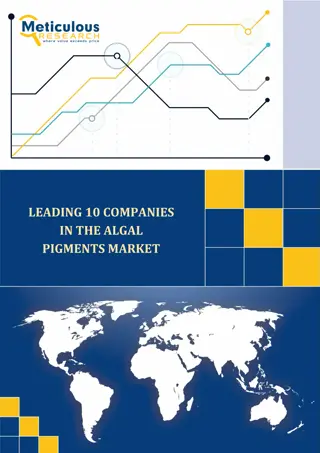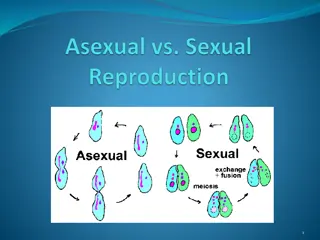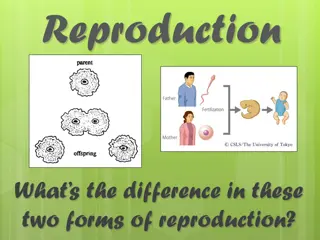Understanding Algal Sexual Reproduction and Life Cycles
Algal sexual reproduction involves various types of gametes, from isogamy to oogamy, with distinct sizes and motility. Algae exhibit different life cycles like haplontic, diplontic, and diplohaplontic, each characterized by specific mechanisms of meiosis and stages of haploid and diploid phases.
Download Presentation

Please find below an Image/Link to download the presentation.
The content on the website is provided AS IS for your information and personal use only. It may not be sold, licensed, or shared on other websites without obtaining consent from the author. Download presentation by click this link. If you encounter any issues during the download, it is possible that the publisher has removed the file from their server.
E N D
Presentation Transcript
SEXUAL REPRODUCTION Gametes may be morphologically identical with vegetative cells or markedly differ from them, depending on the algal group. The main difference is obviously the DNA content that is haploid instead of diploid. Different combinations of gamete types are possible, In the case of isogamy, gametes are both motile and indistinguishable.
When the two gametes differ in size, we have heterogamy. This combination occurs in two types: anisogamy, where both gametes are motile, but one is small (sperm) and the other is large (egg); Oogamy, where only one gamete is motile (sperm) and fuses with the other that is non-motile and very large (egg).
Algae exhibit three different life cycles with variation within different groups. The main difference is the point where meiosis occurs and the type of cells it produces, and whether there is more than one free-living stage in the life cycle.
Haplontic or Zygotic Life Cycle This cycle is characterized by a single predominant haploid vegetative phase, with the meiosis taking place upon germination of the zygote. Chlamydomonas (Chlorophyta) exhibits this type of life cycle.
Diplontic or Gametic Life Cycle This cycle has a single predominant vegetative diploid phase, and the meiosis gives rise to haploid gametes. Diatoms (A) and Fucus (B) have a diplontic cycle.
Diplohaplontic or Sporic Life Cycles These cycles present an alternation of generation between two different phases consisting in a haploid gametophyte and a diploid sporophyte. The gametophyte produces gametes by mitosis; the sporophyte produces spores through meiosis.
Alternation of generation in the algae can be isomorphic, in which the two phases are morphologically identical as in Ulva (Chlorophyta) (C) or heteromorphic, with the predominance of the sporophyte as in Laminaria (D) or with the predominance of the gametophyte as in Porphyra (Rhodophyta) (E).
Anatomy CYTOMORPHOLOGY AND ULTRASTRUCTURE The description of the algal cell will proceed from the outside structures to the inside components. Details will be given only for those structures that are not comparable with analogue structures found in most animals and plants.
OUTSIDE THE CELL Cell surface forms the border between the external word and the inside of the cell. It serves a number of basic functions, including species identification, uptake and excretion/secretion of various compounds, protection against desiccation, pathogens, and predators, cell signaling and cell cell interaction.
It serves as an osmotic barrier, preventing free flow of material, and as a selective barrier for the specific transport of molecules. Algae, besides naked membranes more typical of animal cells and cell walls similar to those of higher plant cells, possess a wide variety of cell surfaces.
The terminology used to describe cell surface structures of algae is sometimes confusing; to avoid this confusion, or at least to reduce it, we will adopt a terminology mainly based on that of Presig et al. (1994).
Cell surface structures can be grouped into four different basic types: . Simple cell membrane (Type 1) . Cell membrane with additional extracellular material (Type 2) . Cell membrane with additional intracellular material in vesicles (Type 3) . Cell membrane with additional intracellular and extracellular material (Type 4)
Type 1: Simple Cell Membrane This cell surface consists of a simple or modified plasma membrane. The unit membrane is a lipid bilayer, 7 8 nm thick, rich of integral and peripheral proteins. Several domains exist in the membrane, each distinguished by its own molecular structure.
Some domains have characteristic carbohydrate coat enveloping the unit membrane. The carbohydrate side chains of the membrane glycolipids and glycoproteins form the carbohydrate coat. Difference in thickness of plasma membrane may reflect differences in the distribution of phospholipids, glycolipids, and glycoproteins
A simple plasma membrane is present in the zoospores and gametes of Chlorophyceae, Xanthophyceae , and Phaeophyceae , and in the spermatozoids of Bacillariophyceae This type of cell surface usually characterizes very short-lived stages and, in this transitory naked phase, the naked condition is usually rapidly lost
The properties of the membrane or its domains may change from one stage in the life cycle to the next.























